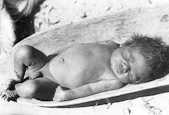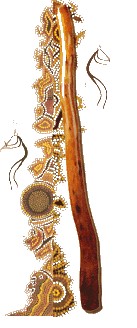 "Aboriginal
man" "Aboriginal
man"

 "Didgeridoo" "Didgeridoo"
 "The
kookaburra" "The
kookaburra"
a relative of the kingfisher, is considered a protector
by the Aborigines, as it feeds on poisonous snakes and
vermin and has an alarming call that resembles haunting
laughter.
 Aboriginal art of "rock painting"is
more than 40.000 years old.
Aboriginal art of "rock painting"is
more than 40.000 years old. |

It happened
in one evening in the year 1988 in a small Brasilian town
called Uni. I used to travel a lot in those times. In my
insatiable desire to experience unknown places and
countries, I arrived in Brazil to visit Dona Vida, a
Slovene woman who lived there. On that particular evening
Dona Vida introduced me to a young Brasilian doctor. The
esoteric society would call him today a chaneller. The
young man made quite an impression on me because of his
very unusual, weird speaking. On my journeys I met very
unusual characters, so I didn't take him too seriously.
The doctor was watching me, staring at me almost too much
as if trying to understand something about me... After
that peculiar gazing at me, he suddenly said: "Yes,
I will speak with them." I couldn't understand
anything any more. After a few days we met again. He
called me from a distance and immidiately started the
conversation. "I have spoken with them", he
said "To whom?" , I asked him. "To
them", he said and pointed with his hand towards the
sky. "Oh really, and what did they tell you?" I
asked him. "You were a man of Tasmania. Very
interesting, very interesting", he repeated. At that
time I simply didn't knowthat Tasmania existed, so I
didn't ask him anymore questions. Later on, Dona Vida
helped me to find Tasmania in her Atlas. I learned that
Tasmania is an island south-east of Australia. With that
the whole story was finished and forgotten.
-------------------------------------------------------------------------------
Two good years passed. It happened that I was in
Australia at this time. Being there for 5 months - in the
south -east of the country, Diana and Gordon Borlase
invited me to see their farm. Their farm bordered the
desert in a small town called Maken Buden, which in
Aboriginal language means "PLace of little
water". Gordon entrusted his big farm to a young
English tenant. He brought his wife and children with him
and they helped him to work on the wide spread land. The
hard work was well repaid with a good harvest of wheat.
Gordon was still farm's owner and very much interested in
its work. We decided to stay one week on the farm and to
have a close look everywhere, specially the big fields,
hundreds and hundreds of acres. One day he stopped
his jeep and invited me to walk with him, telling me he
would like to show me something very interesting. His
farm was cleaned up from the bush already by his father
and what his father couldn't do, he continued, until his
tenant took over. But everything was not cleaned up.
Between two fields there was a narrow passage of land
still covered with bush, complitely virgin and Gordon
wanted to show me exactly that piece of land. Gordon just
couldn't tell me why this passage was untouched by his
father and by him. He remembered that in his childhood
there was found a specially formed stone in this
particular bush. They still have that stone and think
it was used by the Aborigines as a tool to prepare food.
After all this talking, we arrived at the point where
Gordon said: "Yes, this is it." I stopped for a
while, and started to look around. There were big
eucalyptus trees which appeared as if from nowhere.
"How interesting, how interesting" - I was
saying to myself. There was a kind of reddish soil and
not much gras. If one steps on it, it breaks and leaves
its sap and whithers very quickly. I felt compassion for
the gras. And then I examined many red-blue parrots in
the branches of the majestic trees. "Of course, this
is sandalwood" - I am thinking " and all these
voices coming from the big branches of the eucalyptus
trees. This is all familiar to me." The whole scene
became instantaneously known to me, so close, that I just
couldn't believe it. "But it is impossible, I was
never here before", I thought. There I was standing
and looking around, more o less confused and suddenly and
very firmly came the words into my mind: "You were
the man of Tasmania." The words sounded so fresh and
new. They were the words of a doctor from Brasil, which I
forgot long ago. "This is impossible", I hear
myself thinking. I never believed that kind of thing,
there is no reincarnation. "Gordon, let's go",
I said. He glanced at me with bewilderment. This
experience stayed with me for a long time. It awakened in
me an added sensitivity and a great interest for
everything regarding the Aborigines, their stories and
traditions. In the following months I met with many
Aboriginal people, and adored their beautiful characters.
They helped me to understand even better their culture,
heritage and their views of life. Soon I even learned
how to play their instrument, the Didgeridoo. I was not
able to connect or to understand what happened to me in
Brasil until I came to Australia. Seeing Australia opened
for me a new understanding and appreciation for the
Aboriginal quality of life. This experience gave me a
deep spiritual connection to the Aboriginal people and a
special understanding that there is no essential
difference between us; we are all part of the whole. And
this the Australian Aboriginals may understand much
better than others.
Dhiraj
|